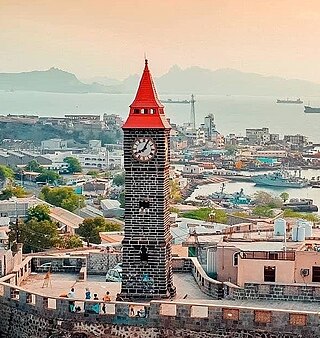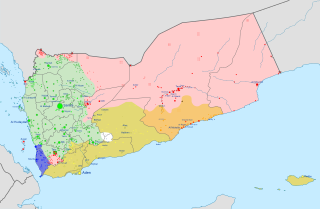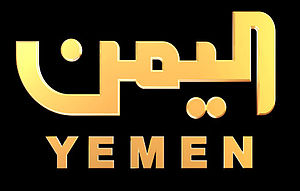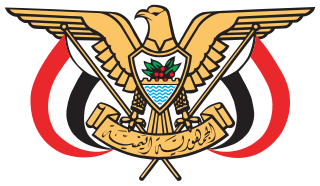Related Research Articles

Aden is a port city located in Yemen in the southern part of the Arabian peninsula, positioned near the eastern approach to the Red Sea. It is situated approximately 170 km east of the Bab-el-Mandeb strait and north of the Gulf of Aden. With its strategic location on the coastline, Aden serves as a gateway between the Red Sea and the Arabian Sea, making it a crucial maritime hub connecting Africa, Asia, and the Middle East. As of 2023, Aden City has a population of approximately 1,080,000 residents, making it one of the largest cities in Yemen.
JeemTV, formerly known as Al Jazeera Children's Channel, is a Qatari pay television channel, aimed at kids between 6 and 12 years old. It was previously co-owned by Al Jazeera Media Network and the Qatar Foundation from launch until June 2013 when Al Jazeera fully acquired the channel. It was then acquired by beIN Media Group on April 1, 2016.

Jiblah is a town in south-western Yemen, c. eight kilometres (5.0 mi) south, south-west of Ibb in the governorate of the same name. It is located at the elevation of around 2,200 metres, near Jabal At-Taʿkar. The town and its surroundings were added to the UNESCO World Heritage Tentative List due to its purported universal cultural value. By 2019 Jiblah University for medical and health science was established in the center of the town of Jiblah. The historical Palace of Queen Arwa is located in the town.
Television in Syria was formed in 1960, when Syria and Egypt were part of the United Arab Republic. It broadcast in black and white until 1976. In 1985 a second channel was established and in 1995 Syrian television rented a channel on Arabsat and it started broadcasting eight hours daily via satellite in 1996. Syrian channels are mostly owned and controlled by the Syrian Arab Television and Radio Broadcasting Commission (SATRBC) which is connected to the Ministry of Information. It has 4,800 staff; both government employees and freelancers.

The National Media Authority, known until 2017 as Egyptian Radio and Television Union, is the public broadcaster of Egypt, operated by the Egyptian government. It is a member of the European Broadcasting Union (EBU) and the Arab States Broadcasting Union (ABSU).

Baraem is a Qatari pay television channel aimed at preschool kids. It was launched on January 16, 2009, and broadcasts 17 hours daily. Previously co-owned by Al Jazeera Media Network and the Qatar Foundation, Al Jazeera acquired full rights to the channel in June 2013. It was then acquired by beIN Media Group on April 1, 2016.
Broadcasting began in Yemen in the 1940s when it was still divided into South by the British and North by Imami ruling system. After the unity of Yemen in 1990, Yemeni government reformed its corporations and founded some additional radio channels which can broadcast locally. However, it drew back after 1994 due to destroyed infrastructures by the civil war. In 1995 it commenced its first TV broadcasting abroad and since then there has been some gradual increase in its radio and television channels most of which belong to the government.
Radio Dabanga (part of Dabanga – Radio TV Online is a radio and online news service that serves Sudan. The shortwave radio has been broadcasting since 1 December 2008. Current broadcasts last for a total of two hours each day. Radio Dabanga introduced an online radio feed in April 2023, broadcasting twenty-four hours a day. Dabanga also publishes its content on Satellite TV, Facebook, WhatsApp, YouTube, and SoundCloud. Depending on the medium, Radio Dabanga produces news in Sudanese Arabic and/or English. Shortwave radio remains the mainstay of the radio station; a high percentage of all Sudanese people are illiterate, a number that is relatively higher in Sudan’s remote areas and camps for displaced people. Many people here have no lifeline to the outside world other than telephone and radio, so it is Radio Dabanga’s mission to provide this. The radio programming is also carried on Dabanga’s satellite TV channel. Both the shortwave and satellite TV can broadcast without censorship and/or technical interference from within Sudan.
Local television is the most significant media platform in Yemen. Given the low literacy rate in the country, television is the main source of news for Yemenis. There are six free-to-air channels currently headquartered in Yemen, of which four are state-owned.
The mass media in South Sudan is underdeveloped compared to many other countries, including fellow East African states like Kenya, Tanzania, and Uganda. Poor transportation infrastructure and entrenched poverty in the country inhibit both the circulation of newspapers, particularly in states located far from the capital of Juba, and the ability of media outlets to maintain regular coverage of the entire country.
The General Organization of Radio and TV, also known in French as Organisation de la Radio et la Télévision Arabe Syrienne, is the state and public broadcaster in Syria and reports to the Ministry of Information. Earlier names were Radio and Television and Syrian Radio & Television (SRT).

Abdel-Aziz bin Habtour is a Yemeni politician who has been the Incumbent prime minister of Yemen since 4 October 2016. He also served as Governor of Aden during the Houthi takeover in Yemen. He is a member of the General People's Congress, sitting on its permanent committee since 1995. An ally of President Abdrabbuh Mansur Hadi, he condemned the 2014–15 Yemeni coup d'état and received the deposed leader after his flight from the Houthi-controlled capital of Sanaa on 21 February 2015. He is also a vocal opponent of the separatist movement in the former South Yemen, saying the movement is too fractured and small to achieve its goals.
Major general Mahmoud al-Subaihi is a Yemeni military officer. He served in the cabinet of President Abdrabbuh Mansur Hadi as defence minister. In the Yemen Army, he holds the rank of major general. He was appointed to head the Ministry of Defence by Prime Minister Khaled Bahah in November 2014.

On 26 March 2015, Saudi Arabia, leading a coalition of nine countries from West Asia and North Africa, launched an intervention in Yemen at the request of Yemeni president Abdrabbuh Mansur Hadi, who had been ousted from the capital, Sanaa, in September 2014 by Houthi insurgents during the Yemeni Civil War. Efforts by the United Nations to facilitate a power sharing arrangement under a new transitional government collapsed, leading to escalating conflict between government forces, Houthi rebels, and other armed groups, which culminated in Hadi fleeing to Saudi Arabia shortly before it began military operations in the country.

Yemen TV is the public national television station in Yemen.
Al-Masirah is a Yemeni TV channel which was founded and is owned by the Ansarullah movement (Houthis). The TV channel is headquartered in Beirut, Lebanon.

The Ministry of Justice is a cabinet ministry of Yemen.
Kamal al-Shawish is a Yemeni human rights activist who was kidnapped by the Houthi militia in August 2018 in the city of Hodeidah.
On 30 December 2020, a plane carrying members of the recently formed Yemeni government landed at Aden International Airport in the southwest of Yemen. As passengers disembarked, there were explosions and gunfire, leaving 28 people dead and 107 others injured. None of the passengers were hurt in the attack and the Yemeni cabinet members were quickly transported to Mashiq Palace for safety.
On March 23, 2022, Houthis assassinated Yemeni army commander Thabet Gawas and three others in a car bombing in Aden, Yemen.
References
- ↑ YemenNet Arabic web site, the reasons for choosing YemeNet Archived 18 December 2009 at the Wayback Machine , (read the discussion page for more clarification)
- ↑ Yemen country profile. Library of Congress Federal Research Division (August 2008). This article incorporates text from this source, which is in the public domain.
- ↑ "Yemen - World Newspapers and Magazines - Worldpress.org". worldpress.org.
- ↑ "Arabic news website". sahafa.com. Archived from the original on 21 August 2009.
- ↑ "Yemen Post Newspaper online- EDITORIAL, LOCAL, INTERVIEW, REPORT, SOCIAL, BUSINESS, HEALTH, OPINION, YEMEN IN THE NEWS, MIDDLE EAST, INTERNATIONAL". yemenpost.net.
- ↑ "صحيفة الأيام -". al-ayyam.info.
- ↑ "الصحوة نت". alsahwa-yemen.net.
- 1 2 "صحيفة الثورة". althawranews.net.
- ↑ "Yemen observer". yobserver.com. Archived from the original on 3 March 2009.
- ↑ "Yemen Times". yementimes.com. Archived from the original on 11 February 2005. Retrieved 23 July 2009.
- ↑ "Almotamar Net, Published by General People's Congress (GPC)". almotamar.net.
- ↑ "www.aleshteraki.net". aleshteraki.net.
- ↑ "صحيفة 14 أكتوبر للصحافة و الطباعة و النشر". Archived from the original on 23 December 2017. Retrieved 23 July 2009.
- ↑ "مجلة تكنولوجيا الاتصالات والمعلومات - تصدر عن وزارة الاتصالات وتقنية المعلومات". مجلة تكنولوجيا الاتصالات والمعلومات.
- ↑ Yushi Chiba (2010). "Media History of Modern Egypt: A Critical Review". Kyoto Working Papers on Area Studies: G-COE Series. p. 6. hdl:2433/155745.
- ↑ The media in Yemen Archived 23 July 2009 at the Wayback Machine , a brief history and general overview about the media, press, television and radio.
- ↑ Radio Frequencies.
- ↑ "Search Results for English SWL Broadcasters at 1042". hfradio.org.
- ↑ "RadioStationWorld - Yemen - Radio and Television". radiostationworld.com.